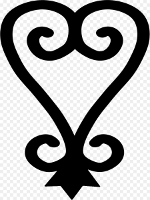Sankofa


How to pronounce Sankofa
The meaning and philosophical significance of Sankofa
Sankofa is an expression in the Twi language of Ghana whose literal meaning is “Go back and get it!” It is actually a fusion of the two words in the Akan second-person imperative sentence, “San kɔfa!”
Its corresponding Akan proverb is, “Se wo were fi na wosan kofa a yenkyiri.” To wit, it is not taboo to go back and get something after you have forgotten it. More literally, it means if you forget and you go back to get it, there is nothing wrong with it.
The preservation and transmission of history in an oral tradition
That history has much to teach is not in question but the injunction to heed the lessons of the past and to revere the custodians of those lessons–the elders–is more pronounced in societies which have nothing more than an oral tradition to transmit their culture and values.
Then, not only is history important, but also those who know it. Further, the literary and narrative monuments the elders establish through their art (as in kente and Adinkra), their stories (as in Ananse and other stories), and their music must be preserved lest their discoveries and contributions be lost forever.
Sankofa is an admonition against arrogance
The arrogance of succeeding generations may lead them to ignore established conventions and traditions because the events and experiences that led to their construction would have long faded out of the general consciousness. That this is a grave error that should be avoided is re-echoed in countless Akan customs and aphorisms.
Sankofa is an Adinkra symbol that embodies the spirit and attitude of reverence for the past, reverence for one’s forebears, reverence for one’s history, and reverence for one’s elders. The mythical bird effortfully bending its neck to reach back for the abandoned but precious egg signifies the diligence required to take due cognizance of the past to give it its proper place in the present. Sankofa is a gentle admonition that if even in our arrogance we overlook the gems from the past, when we come to our senses we should be humble enough to retrace our steps and make amends.
Two Sankofa symbols: the mythical Sankofa bird and the stylized heart
There are two different symbols that both represent Sankofa. The more popular one is the bird with the contorted neck but the other one which looks more like the conventional symbol for the heart is also used. This figure is symmetrical about a vertical axis with each half spotting two spirals, one at the top and the other at the bottom. The spirals probably represent the idea of going around but ending up at a point–presumably the source.
The significance of Sankofa to Africans in the diaspora
African Americans, Africans in the Carribbean, and all those who ended up on foreign shores as victims of the Trans-Atlantic slave trade often feel a longing for their African roots. When this natural longing inspires spiritual quests for meaning and association, the quest traverses indigenous African culture, spirituality, and art, which includes symbols. It is for this reason that Sankofa has become a totem for many Africans in the diaspora as they explore and seek connections to their roots. This is apt for just as those who do not know history are doomed to repeat it, so are those who do not know their roots doomed to incognizance and the repitition of their ancestors’ mistakes.
With every appeal to show regard for the past comes the objections about the obvious flaws and sins of past generations. This is especially true in the case of the enslavement of black people as the vast majority, about 90% of them, were first enslaved and then sold by their own kin. However, we need not deify the actors to learn from them. Neither do we need to sanitize their legacies or purge their sins from memory. We only need to take their histories for what they are–flawed as they were, blind as they were, wrong as they were–and strive to do better. It behooves us to sift the wheat from the chaff and draw the useful lessons for the present age. That is the point of Sankofa: we should not forget our roots for its tendency is to feature inexorably in every aspect of our lives.
Akan aphorisms relating to the meaning of Sankofa
- Tete wo bi ka, tete wo bi kyere
- Wo were fi na wosan kofa a yenkyiri
- Okyem tete a eka ne mmeremu
- Tete na atete ama amanfoo anya bi apempam
- Kuntu hwane a eko nakyi
- Tete asoeee, wonsoee ho bio Some practices from the past must be done away with
Sankofa in logos and emblems
References
- The first Sankofa image was obtained from the website of the Carter G. Woodson Center.
- The second Sankofa image was obtained from CleanPNG.